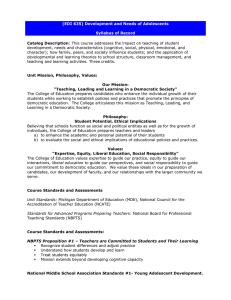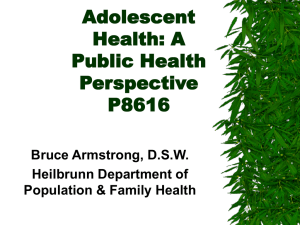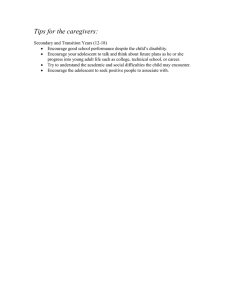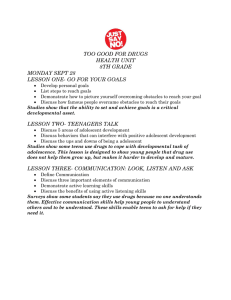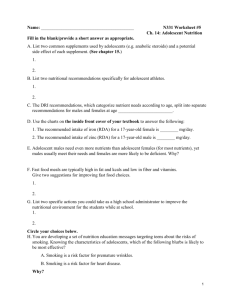Document 17979964
advertisement
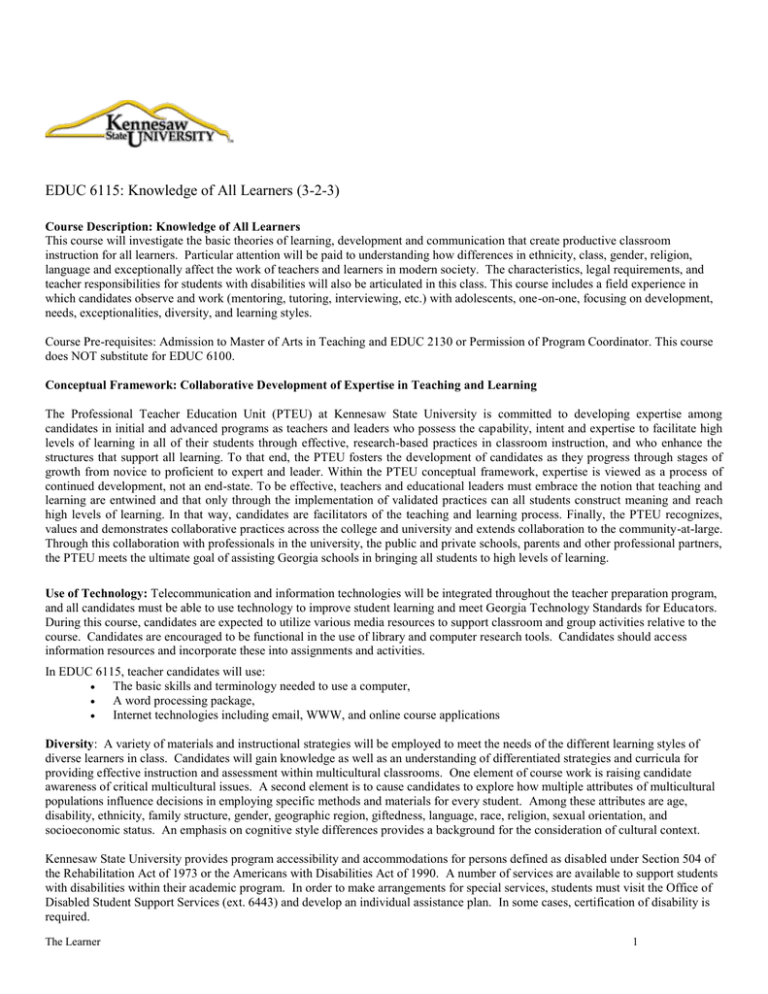
EDUC 6115: Knowledge of All Learners (3-2-3) Course Description: Knowledge of All Learners This course will investigate the basic theories of learning, development and communication that create productive classroom instruction for all learners. Particular attention will be paid to understanding how differences in ethnicity, class, gender, religion, language and exceptionally affect the work of teachers and learners in modern society. The characteristics, legal requirements, and teacher responsibilities for students with disabilities will also be articulated in this class. This course includes a field experience in which candidates observe and work (mentoring, tutoring, interviewing, etc.) with adolescents, one-on-one, focusing on development, needs, exceptionalities, diversity, and learning styles. Course Pre-requisites: Admission to Master of Arts in Teaching and EDUC 2130 or Permission of Program Coordinator. This course does NOT substitute for EDUC 6100. Conceptual Framework: Collaborative Development of Expertise in Teaching and Learning The Professional Teacher Education Unit (PTEU) at Kennesaw State University is committed to developing expertise among candidates in initial and advanced programs as teachers and leaders who possess the capability, intent and expertise to facilitate high levels of learning in all of their students through effective, research-based practices in classroom instruction, and who enhance the structures that support all learning. To that end, the PTEU fosters the development of candidates as they progress through stages of growth from novice to proficient to expert and leader. Within the PTEU conceptual framework, expertise is viewed as a process of continued development, not an end-state. To be effective, teachers and educational leaders must embrace the notion that teaching and learning are entwined and that only through the implementation of validated practices can all students construct meaning and reach high levels of learning. In that way, candidates are facilitators of the teaching and learning process. Finally, the PTEU recognizes, values and demonstrates collaborative practices across the college and university and extends collaboration to the community-at-large. Through this collaboration with professionals in the university, the public and private schools, parents and other professional partners, the PTEU meets the ultimate goal of assisting Georgia schools in bringing all students to high levels of learning. Use of Technology: Telecommunication and information technologies will be integrated throughout the teacher preparation program, and all candidates must be able to use technology to improve student learning and meet Georgia Technology Standards for Educators. During this course, candidates are expected to utilize various media resources to support classroom and group activities relative to the course. Candidates are encouraged to be functional in the use of library and computer research tools. Candidates should access information resources and incorporate these into assignments and activities. In EDUC 6115, teacher candidates will use: The basic skills and terminology needed to use a computer, A word processing package, Internet technologies including email, WWW, and online course applications Diversity: A variety of materials and instructional strategies will be employed to meet the needs of the different learning styles of diverse learners in class. Candidates will gain knowledge as well as an understanding of differentiated strategies and curricula for providing effective instruction and assessment within multicultural classrooms. One element of course work is raising candidate awareness of critical multicultural issues. A second element is to cause candidates to explore how multiple attributes of multicultural populations influence decisions in employing specific methods and materials for every student. Among these attributes are age, disability, ethnicity, family structure, gender, geographic region, giftedness, language, race, religion, sexual orientation, and socioeconomic status. An emphasis on cognitive style differences provides a background for the consideration of cultural context. Kennesaw State University provides program accessibility and accommodations for persons defined as disabled under Section 504 of the Rehabilitation Act of 1973 or the Americans with Disabilities Act of 1990. A number of services are available to support students with disabilities within their academic program. In order to make arrangements for special services, students must visit the Office of Disabled Student Support Services (ext. 6443) and develop an individual assistance plan. In some cases, certification of disability is required. The Learner 1 MODULE I: Knowledge of All Learners REQUIRED TEXT: Santrock, John W. (2007). Adolescence (11th ed.) New York: McGraw-Hill Higher Education. COURSE OBJECTIVES: Upon completion of this module each teacher candidate will accomplish objectives as indicated in the grid that follows. Course Goals and Objectives 1. CPI Outcome/NCATE Standard* GA Framework for Teaching 2.2.1 Apply major theoretical perspectives and principles of development and learning in children and adolescents advocated by such scholars as Piaget, Maslow, Erikson, Bandura, Bloom, Kohlberg, Gardner, and Vygotsky. Describe normative research methods and techniques used to study behavior and development change in learners. 2.1 Standard I 1.4, 2.1 Standard I 2.4.1 3. Describe how instruction and learning evolves from the study of human growth and development 2.4, 2.6, 2.7 Standard I 2.1.1 2.5.1 4. Describe how genetic, health, and environmental factors influence the process of development and learning. 2.1, 2.3 Standard I, II 2.2.1 5. Describe social, moral, emotional, physical, cognitive, and physiological development and the interrelationships among these domains as related to learners. Analyze the cultural, economic, social, ecological, political and educational influences on development. 2.1 2.5.1 Standard I 2.3 Standard I, II 2.1.1. 2.3.1 7. Use current technology to access research. 8. Articulate the sequence and characteristics of life span development with special emphasis on middle childhood, adolescence, and young adulthood. 1.4 Standard I 2.1 2. 6. 9. Identify factors inside and outside the home, which affect successful growth and development as related to family system theory, knowledge of the dynamics, roles, and relationships within families and communities. 10. Identify current issues in child development. 11. Explain and apply methods of studying child development 12. Apply the knowledge and principles of human growth, development, and learning theories when observing learners at various stages of development. 13. Exhibit the ability to work cooperatively with peers, parents and others. 2.5.1 Standard I 2.2, 2.3 Standard I, II 2.1, 2.2 Standard I 1.4, 2.1 Standard I 2.3.1 2.5.1 2.2.1 2.1 2.2.1 Standard I 3.2, 3.3 5.7.1 Standard I The Learner 3.2.1 Assignments and Activities Formal Assessment (Exam) Group Presentation Research Article Review Formal Assessment Formal Assessment (Exam) Observation and Narrative Observation and Narrative Group Presentation Observation Reflection Group Presentation Immersion Reflection Observation and Narrative Research Article Review Formal Assessment Observation and Narrative Text Readings Observation and Narrative Formal Assessment Research Article Review Formal Assessment Observation and Narrative Observation and Narrative Group Presentation Professionalism Evaluation from field experience Group Presentation Small Group Activities 2 Course Goals and Objectives CPI Outcome/NCATE Standard* GA Framework for Teaching 6.3.1 Assignments and Activities Professionalism Evaluation from field experience Group Presentation Small Group Activities *“Outcomes” refers to outcomes evaluated in the Candidate Performance Instrument (CPI). The National Council for Accreditation of Teacher Education (NCATE) Standards can be found at www.ncate.org. 14. Exhibit ethical standards in course work and relationships with others. 3.3, 3.4 Standard I Course Assignments and Requirements (Module I) 1. 2. Reflective Journal: (40 points [8 points per question]) Each teacher candidate will maintain an electronic journal of their typed reflections based on chapter questions. Observations: (50 points each) Teacher candidates will observe two adolescent individuals in their natural environments (e.g., at school, work, home, and play). Individual observations, in narrative form, will be due on the dates specified in the course outline. Your first observation will involve a student from the U. S. American middle-class Caucasian culture. Your second observation will involve a student from the minority culture chosen by your cooperative group. An Observation Guide to use while you observe your student for at least 30 minutes will be provided. If necessary, be sure to obtain permission to observe the student from a parent or guardian with the understanding that participation is voluntary and all information will remain confidential. We will discuss in class the ethics involved in an the observation, and the ethics involved in your narrative. Please note, this is an observation – not an interview. These two observation narratives will form the foundation of a group presentation, so be sure to keep a paper and disk copy of each narrative to share with your collaborative group. 3. 4. 5. Collaborative Group Presentation: (30 points) Teacher candidates will be assigned into groups by their subject area concentrations. Your group presentation will integrate your data from your two observations with those of your group members and apply your conclusions toward the research discussed in the text and possible implications for teaching. Research Article Project: (40 points) Working with a partner, you will locate copy and read one research article related to adolescent development. The primary goals of this assignment are 1) to be able to locate a research article of interest in databases and 2) to read and understand current research and recommendations in an area of interest. More information on this project will be given in class including instruction on searching electronic databases. Partners will prepare and present a PowerPoint in which you review the article according to the guidelines provided to you. Exam: (100 points) There will be one exam. The test will be multiple-choice, essay, and possibly open-book. All questions are based on assigned readings from Santrock. Teacher candidates are expected to take tests on scheduled dates with the class. Class notes, PowerPoints, and posted handouts will point you to the topic/concept that will be questioned on the test. Module II : Diversity Required Text: Salend, Spencer J. (2007). Creating inclusive classrooms: Effective & reflective practices. (6th Ed.). Upper Saddle River, NJ: Merrill Prentice Hall. COURSE OBJECTIVES: Upon completion of this module each teacher candidate will accomplish objectives as indicated in the grid that follows. Course Goals and Objectives 1. 2. The Learner Understand how differences in ethnicity, class, gender, religion, language and exceptionality affect the work of schools and teachers in modern society. Articulate the legal and ethical requirements of their role in the education of students CPI Outcomes & NCATE Standards* 2.3 GA Framework for Teaching 2.1.1 Research Article Review Proficiency Exams 6.2.1 Proficiency Exams Quizzes/Tests Standard I, II 3.4 Assignments and Activities 3 Course Goals and Objectives with disabilities and the ways those continue to evolve out of legislative, litigative, and sociological changes. Demonstrate an understanding of the way in which general characteristics of exceptionalities are linked to definitions under state and federal laws and the attendant regulations. Demonstrate an understanding of due process and their role in its implementation for parents and students and their role in engaging and supporting the participation of parents of students with diverse characteristics (including disabilities) in the education of their children. Demonstrate an understanding of disabilities as lifelong circumstances requiring different strategies and accommodations in various settings and stages. Demonstrate the ability to identify community and professional resources and collect information about their access. 3. 4. 5. 6. CPI Outcomes & NCATE Standards* GA Framework for Teaching Assignments and Activities Standard I 2.1, 3.4 2.2.1 6.2.1 Proficiency Exams Quizzes/Tests 6.2.1 Proficiency Exams Quizzes/Tests 2.3.1 Proficiency Exams Standard I 3.3, 3.4 Standard I 2.3, 2.4 Standard I 2.3, 2.4, 2.6, 2.7, 2.8 Standard I 3.4 6.2.1 Cultural Immersion Experience Cultural Immersion Experience Standard I Professionalism evaluation from field experience *“Outcomes” refers to outcomes evaluated in the Candidate Performance Instrument (CPI). The National Council for Accreditation of Teacher Education (NCATE) Standards can be found at www.ncate.org. 7. Exhibit a commitment to teaching in a diverse world. 2.1.1 Course Requirements and Assignments (Module II): 1. Research/Review/Respond: (40 points) Locate and read a research article addressing issues in educating students with disabilities in your primary area of interest, e.g. Science or Math. Therefore, If you are pursuing an MAT in Math you must find an article on teaching math to students with disabilities in the general education classroom. The primary goal is to read and understand current research or recommendations in an area of interest and then be able to discuss the topic in class. The articles can be located through technology tools such as CD-ROM, WWW, Galileo, ERIC, microfilm or microfiche, etc. You may also use the bibliography provided with this syllabus. You are encouraged to go to the library and explore the resources available to you. 2. Proficiency Exam: (150 points) One examination, with two parts (described below) will be completed on-line during a designated time period. Both of these exams require a minimum score of 80% correct responses in order to receive a passing grade in this course. More than one retake to meet mastery will entail a personal and private conference with the instructor to develop a remediation plan. The Learner Legislation and Litigation Proficiency Exam: The knowledge and understanding of public laws focusing on the provision of special education services is an important segment of this course. As a teacher, you will be asked to collaborate with other service givers to provide educational opportunities for all students, including those with disabilities. State and federal laws that you must understand stringently regulate the provision of those services. The content of this assessment is the application of the laws studied in class and will be evaluated for knowledge and comprehension. 4 Disability Characteristics Proficiency Exam: It is important that candidates have an understanding of disability categories contained within the Federal Regulations for Special Education as well as the characteristics and learning needs of students identified with those disability categories. This assessment tests the knowledge of candidates in these areas. 3. Cultural Immersion Experience Essay & Resource Guide: (75 points) Interview/interact with an adult of a different race, religion, sexual orientation, physical ability, cognitive ability, etc. than your own OR participate in an in-depth cultural experience approved by the instructor. Reflect on your experience and what you learned about yourself and the culture you experienced in a three-page essay. (See rubric for grading criteria.) Create Diversity Resource Guide: Identify five community services to assist you in teaching students and relating to families of cultures similar to the individuals with whom you interacted. Organize the resources from WebCT into a resource guide for students with disabilities. Modular III: Field Experience (30 hours) COURSE OBJECTIVES: Upon completion of this module each teacher candidate will accomplish objectives as indicated in the grid that follows. Course Goals and Objectives 1. 2. Demonstrate an awareness and sensitivity to students from different backgrounds as related to the concepts of race, socioeconomic status, ethnicity, religion, language, gender, and exceptionalities. Describe how the concepts of race, socioeconomic status, ethnicity, religion, language differences, gender and exceptionality affect student performance and teacher expectations. 3. Describe how the cultural background, language differences, cognitive abilities, and exceptionalities of a learner influence participation in the educational setting. 4. Discuss communication and learning styles of diverse learners in middle grades and secondary classrooms. Demonstrate an understanding of their role in engaging and supporting the participation of parents of diverse students in the education of their children. Explain major theoretical perspectives of learning (cognitive, developmental, social learning, behavioral, and human information processing) and their role in the education of diverse learners. 5. 6. 7. The Learner Describe contexts when different theoretical positions would be appropriate for use with CPI Outcomes & NCATE Standards GA Framework for Teaching Assignments and Activities 2.3.1 Observations and Reflections 2.1.1 Observations, Reflections, & Conclusions 2.1.1 2.3.1 Observations, Reflections, & Conclusions Standard I, II 2.1, 2.3 2.5.1 Standard I, II 3.3 2.3.1 Observations, Reflections, & Conclusions Observations, Reflections, & Conclusions 2.3, 3.3 Standard I, II 2.3, 2.5 Standard I, II 2.1, 2.2, 2.3, 2.4 Standard I, II CPI – Facilitator of Learning, Collaborative Professional NCATE – Standard I (Knowledge, Skills, and Dispositions), Standard II (Diversity) CPI – Facilitator of Learning 2.2.1 Observations, Reflections, & Conclusions 2.5.1 Observations, Reflections, & 5 Course Goals and Objectives CPI Outcomes & NCATE Standards GA Framework for Teaching Assignments and Activities NCATE – Standard I Conclusions (Knowledge, Skills, and Dispositions) *“Outcomes” refers to outcomes evaluated in the Candidate Performance Instrument (CPI). The National Council for Accreditation of Teacher Education (NCATE) Standards can be found at www.ncate.org. diverse learners. Course Assignments and Requirements (Module III): 1. Professionalism: It is expected that future teachers will conduct themselves with the professionalism that is required of practicing teachers. MAT teacher candidates are entering a profession of extremely high standards that they are expected to live up to daily. Keep in mind that the way that you deal with peers and faculty has proved to be indicative of how you will deal with your future students, colleagues, and administrators. The Teacher Candidate shows acceptable professional ability to: Communicate effectively orally and in writing Reflect upon and improves professional performance. Builds collaborative and respectful relationships with colleagues, supervisors, students, parents and community members. Displays professional and ethical behavior. 2. Experiential Service Learning Project (150 points) – Candidates will arrange to spend one-on-one time with adolescents and/or young adults in the role of tutor and mentor, applying the concepts studied in this course. You should spend at least thirty hours with an adolescent, documenting the dates and times of your meetings. You should also make efforts to work with a diverse population. Choose to work with males and females and/or middle grades and secondary students. Keep in mind that any one student might represent several diverse characteristics. Consider selecting students to work with who are From a culture different from yours Are language minority Have special physical or cognitive needs Candidates will be given a total of six directed activities to use while working with students. There will be two activities for each module. These activities may include but are not limited to Determining the students’ preferred learning modalities, multiple intelligences, motivational factors, etc. Investigating conditions of students’ educational environments and experiences. Reflecting upon the impact of the students’ diversities and exceptionalities on learning. Collecting observational data that might be useful for decision-making. Communicating with the students’ parents or guardians regarding your relationship and observations. Opportunities to work with students may include the following: Church or synagogue youth groups Scout troops Your children or relatives The children of friends or neighbors Students at your school (if you are employed) Service-learning opportunities through KSU (information will be provided) You will be required to verify that the students you work with are there on a voluntary basis, and that they may chose to discontinue working with you at any time without fear of any type of penalty. You are also required to verify that you are covered by liability insurance. More information will be provided about how to acquire this insurance in class. Evaluation and Grading (based from a total of 650 points from the three modules): 90% - 100% Excellent A 70% - 79% Satisfactory 80% - 89% Good B 60% - 69% Less than satisfactory (must re-take course) The Learner C D 6 Academic Honesty: Every KSU student is responsible for upholding the provisions of the Student Code of Conduct, as published in the Undergraduate and Graduate Catalogs. Section II of the Student Code of Conduct addresses the University’s policy on academic honesty, including provisions regarding plagiarism and cheating, unauthorized access to University materials, misrepresentation/falsification of University records or academic work, malicious removal, retention, or destruction of library materials, malicious/intentional misuse of computer facilities and/or services, and misuse of student identification cards. Incidents of alleged academic misconduct will be handled through the established procedures of the University Judiciary Program, which includes either an “informal” resolution by a faculty member, resulting in a grade adjustment, or a formal hearing procedure, which may subject a student to the Code of Conduct’s minimum one semester suspension requirement. Adolescent Development Berk, Laura E. (2002). Child development. Boston: Allyn & Bacon. Berk, Laura E. (2002) Infants, children, and adolescents. Boston: Allyn & Bacon. Berns, Roberta M. (1994). Topical child development. Belmont, CA: Wadsworth Publishing. Daniels, Denise, Beaumont, Lorrie, and Doolin, Carol. (2001). Understanding children: An interview and observation guide for educators. Columbus, OH: McGraw-Hill. Gearheart, Bill R. and Gearheart, Carol J. (1993). Exceptional individuals: An introduction. Belmont, CA: Wadsworth Publishing. Owens, Karen B. (2002). Child and adolescent development. Belmont, CA:Wadsworth Publishing. Santrock, John W. (2002). A topical approach to life-span development. Boston: McGraw-Hill. Shaffer, David R. (2002). Developmental psychology: Childhood and adolescence. Belmont, CA: Wadsworth Group. Schickedanz, Judith A. and Schickedanz, David I. (2001). Understanding children and adolescents. Boston: Allyn & Bacon. Adolescent Literature Fox, Paula. (1991). Monkey island. New York: Doublesday Dell Books Freedman, Russell. (1994). Kids at work: Lewis Hine and the crusade against child labor. New York: Scholastic Mers, Walter. D. (1993). Malcolm X: By any means possible. New York: Scholastic Inc. Hamanaka, Sheila. (1995). On the wings of peace: In memory of Hiroshima and Nagasaki. New York: Houghton Mifflin Company. Tsuchiya, Yukio. (1988). Faithful elephants: A true story of animals, people and war. New York: Houghton Mifflin Company. Teacher Resources Alboun, M. (1997). Tuesdays with Morrie. New York: Doubleday. Crawford, Susan Hoy. (1996). Beyond dolls and guns: 101 ways to help children avoid gender bias. Portsouth, N. H.: Heinemann Fadiman, Anne. (1997). The spirit catches you and you fall down. New York: The Noonday Press Fedullo, Mick, (1992). Light of the feather: Pathways through contemporary Indian America. New York: William Morrow. Levine, D., Lowe, R., Peterson, B., & Tenorio, R. (1995). Rethinking schools: An agenda for change. New York: The New Press Recent Journal Articles Puberty, Health, and Biological Foundations Hermes, S. F., & Keel, P. K. (2003). The influence of puberty and ethnicity on awareness and internalization of the thin ideal. International Journal of Eating Disorders, 33, 465-468. Snyman, M. V., Poggenpoel, M.,& Myburgh, C. P. H. (2003). Young adolescent girls’ experience of non-clinical depression. Education, 124, 269-289. Talpade, M., & Talpade, S. (2001). Early puberty in African American girls: Nutrition past and present. Adolescence, 36, 789-795. Xiaojia, G., Conger, R.D., & Elder, Jr., G.H. (2001). The relation between puberty and psychological distress in adolescent boys. Journal of Research on Adolescence, 11, 49-71. Cognitive Development Flieller, A. (1999). Comparison of the development of formal thought in adolescent cohorts aged 10 to 15. Developmental Psychology, 35, 1048-1059. Families Engels, R.C.M.E., Dekovic, M., & Meeus, W. (2002). Parenting practices, social skills and peer relationships in adolescence. Social Behavior & Personality: An International Journal, 30, 3-18. The Learner 7 Galinsky, E. (2001). What children want from parents—and how teachers can help. Educational Leadership, 58, 24-29. Kung, E.M., & Farrell, A.D. (2000). The role of parents and peers in early adolescent substance use: an examination of mediating and moderating effects. Journal of Child & Family Studies, 9, 509-529. Mounts, N.S. (2002). Parental management of adolescent peer relationships in context: the role of parenting style. Journal of Family Psychology, 16, 58-70. Richardson, S., & McCabe, M.P. (2001). Parental divorce during adolescence and adjustment in early adulthood. Adolescence, 36, 467-490. Rodgers, K.B., & Rose, H.A. (2002). Risk and resiliency factors among adolescents who experience marital transitions. Journal of Marriage & the Family, 64, 1024-1038. Updegraff, K.A., Mchale, S.G., Grouter, A.C., & Kupanoff, K. (2001). Parents’ involvment in adolescents’ peer relationships: a comparison of mothers’ and fathers’ roles. Journal of Marriage & the Family, 63, 655-669. Peers Azmitia, M., & Cooper, C.R. (2001). Good or bad? Peer influences on Latino and European adolescents’ pathways through school. Journal of Education for Students Placed at Risk, 6, 45-72. Craig, W.M., Vitaro, F., Gagnon, C., & Tremblay, R.E. (2002). The road to gang membership: characteristics of male gang and nongang members from ages 10 to 14. Social Development, 11, 53-69. Engels, R.C.M.E., Dekovic, M., & Meeus, W. (2002). Parenting practices, social skills and peer relationships in adolescence. Social Behavior & Personality: An International Journal, 30, 3-18. Furman, W. (2002). The emerging field of adolescent romantic relationships. Current Directions in Psychological Science, 11, 177181. McCabe, M. P., & Ricciardelli, L. A. (2003). Sociocultural influences on body image and body changes among adolescent boys and girls, Journal of Social Psychology,143, 25-27. Mounts, N.S. (2002). Parental management of adolescent peer relationships in context: the role of parenting style. Journal of Family Psychology, 16, 58-70. Prinstien, M.J., & La Greca, A.M. (2004). Childhood peer rejection and aggressive as predictors of adolescent girls’ externalizing and health risk behaviors: a 6-year longitudinal study. Giordano, P.C. (2003). Relationships in adolescence. Annual Review of Sociology, 29, 257-282. Updegraff, K.A., Mchale, S.G., Grouter, A.C., & Kupanoff, K. (2001). Parents’ involvment in adolescents’ peer relationships: a comparison of mothers’ and fathers’ roles. Journal of Marriage & the Family, 63, 655-669. Schools Certo, J.L., Cauley, K.M., & Chafin, C. (2003). Students’ perspectives on their high school experience. Adolescence, 38, 705-725. Culture Azmitia, M., & Cooper, C.R. (2001). Good or bad? Peer influences on latino and european adolescents’ pathways through school. Journal of Education for Students Placed at Risk, 6, 45-72. Giordano, P.C. (2003). Relationships in adolescence. Annual Review of Sociology, 29, 257-282. Hermes, S. F., & Keel, P. K. (2003). The influence of puberty and ethnicity on awareness and internalization of the thin ideal. International Journal of Eating Disorders, 33, 465-468. McCabe, M. P., & Ricciardelli, L. A. (2003). Sociocultural influences on body image and body changes among adolescent boys and girls, Journal of Social Psychology,143, 25-27. Talpade, M., & Talpade, S. (2001). Early puberty in African American girls: Nutrition past and present. Adolescence, 36, 789-795. The Self Certo, J.L., Cauley, K.M., & Chafin, C. (2003). Students’ perspectives on their high school experience. Adolescence, 38, 705-725. Richardson, S., & McCabe, M.P. (2001). Parental divorce during adolescence and adjustment in early adulthood. Adolescence, 36, 467-490. Rodgers, K.B., & Rose, H.A. (2002). Risk and resiliency factors among adolescents who experience marital transitions. Journal of Marriage & the Family, 64, 1024-1038. Furman, W. (2002). The emerging field of adolescent romantic relationships. Current Directions in Psychological Science, 11, 177181. Gender Hermes, S. F., & Keel, P. K. (2003). The influence of puberty and ethnicity on awareness and internalization of the thin ideal. International Journal of Eating Disorders, 33, 465-468. The Learner 8 Snyman, M. V., Poggenpoel, M.,& Myburgh, C. P. H. (2003). Young adolescent girls’ experience of non-clinical depression. Education, 124, 269-289. Updegraff, K.A., Mchale, S.G., Grouter, A.C., & Kupanoff, K. (2001). Parents’ involvment in adolescents’ peer relationships: a comparison of mothers’ and fathers’ roles. Journal of Marriage & the Family, 63, 655-669. Sexuality Furman, W. (2002). The emerging field of adolescent romantic relationships. Current Directions in Psychological Science, 11, 177-181. Giordano, P.C. (2003). Relationships in adolescence. Annual Review of Sociology, 29, 257-282. Moral Development Demetrious, A., & Charitides, L. (1986). The adolescent’s construction of Procedural justice as a function of age, formal thought and sex. International Journal of Psychology, 21, 333-354. Adolescent Problems Craig, W.M., Vitaro, F., Gagnon, C., & Tremblay, R.E. (2002). The road to gang membership: characteristics of male gang and nongang members from ages 10 to 14. Social Development, 11, 53-69. Engels, R.C.M.E., Dekovic, M., & Meeus, W. (2002). Parenting practices, social skills and peer relationships in adolescence. Social Behavior & Personality: An International Journal, 30, 3-18. Galinsky, E. (2001). What children want from parents—and how teachers can help. Educational Leadership, 58, 24-29. Kung, E.M., & Farrell, A.D. (2000). The role of parents and peers in early adolescent substance use: an examination of mediating and moderating effects. Journal of Child & Family Studies, 9, 509-529. Prinstien, M.J., & La Greca, A.M. (2004). Childhood peer rejection and aggressive as predictors of adolescent girls’ externalizing and health risk behaviors: a 6-year longitudinal study. Journal of Consulting & Clinical Psychology, 72, 103-113. Storch, E.A., Brassard, M.R., & Masia-Warner, C.L. (2003). The relationship of peer victimization to social anxiety and loneliness in adolescence. Child Study Journal, 33, 1-19. Xiaojia, G., Conger, R.D., & Elder, Jr., G.H. (2001). The relation between puberty and psychological distress in adolescent boys. Journal of Research on Adolescence, 11, 49-71. Diversity Anderson, N. (1999). Exploring second language reading: Issues and strategies. Boston: Heinle & Heinle. Armstrong, T. (2000). Multiple intelligences in the Classroom (2nd ed.). Alexandria, Virginia: Association for Supervision and Curriculum Development. Alexander, P. A. (2006). Psychology in learning and instruction. Upper Saddle River, NJ: Merrill Prentice Hall. Banks, J. A., & McGee Banks, C. A., (1997). Multicultural education: Issues and perspectives. Needham Heights, MA: Allyn & Bacon. Berk, Laura E. (2002). Child development. Boston: Allyn & Bacon. Berk, Laura E. (2002) Infants, children, and adolescents. Boston: Allyn & Bacon. Berns, Roberta M. (1994). Topical child development. Belmont, CA: Wadsworth Publishing. Boyle, T. C. (1995). The tortilla curtain. New York: Viking Press. Coady, M., & Escamilla, K. (2005). Audible voices, visible tongues: Exploring social realities in Spanish-speaking students’ writing. Language Arts, 82(6), 462-471. Daniels, Denise, Beaumont, Lorrie, and Doolin, Carol. (2001). Understanding children: An interview and observation guide for educators. Columbus, OH: McGraw-Hill. Delpit, L. (1995). Other people’s children. New York: New Press. Gay, G. (2000). Culturally responsive teaching: Theory, research, and practice. NY: Teachers College Press. Gearheart, Bill R. and Gearheart, Carol J. (1993). Exceptional individuals: An introduction. Belmont, CA: Wadsworth Publishing. Gee, R. W. (1999). Encouraging ESL students to read. TESOL Journal, 8(1), 3-7. Genesee, F., & Upshur, J. A. (2002). Classroom-based evaluation in second language education. Cambridge, UK: Cambridge University Press. Greenwood, G. E., Fillmer, H. T., & Parkay, F. W. (2002). Educational psychology cases. (2nd ed.).Upper Saddle River, NJ: Merrill Prentice Hall. Harry, B. (1992). Cultural diversity, families and the special education system. New York, New York: Teachers College Press. The Learner 9 Hertzog, N.B. (1998). The changing role of the gifted education specialist. Teaching Exceptional Children, 30, 39-43. Johnson, D. W., Johnson, R. T., & Holubec, E. J. (1994). The new circles of learning: Cooperation in the classroom and school. Alexandria, Virginia: Association for Supervision and Curriculum Development. Kennedy, C. & Horn, E. (2004). Including students with severe disabilities, Boston, MA: Allyn & Bacon. Klingner, J.K., Vaughn, S., Schumm, J.S., Cohen, P. & Forgan, J.W. (1998). Inclusion or pull-out: Which do students prefer? Journal of Learning Disabilities, 31, 148-158. Lipman, P. (1998). Race, class and power in school restructuring. Albany, NY: SUNY Press. Mastropieri, M.A., & Scruggs, T. E. (2000). The Inclusive Classroom: Strategies for Effective Instruction. Upper Saddle River, NJ: Prentice-Hall. Meyer, L. (2000). Barriers to meaningful instruction for English learners. Theory Into Practice 39(4), 228-236. Nisbett, R. E. (2003). Geography of thought: How Asians and Westerners think differently. New York: Free Press. O’Malley, J. M., & Chamot, A. U. (1990). Learning strategies in second language acquisition. Cambridge: Cambridge University Press. Ormrod, J. E. (2006). Educational psychology: Developing learners. (5th ed.). Upper Saddle River, NJ: Merrill Prentice Hall. Ovando, C. J., Collier, V. P., & Combs, M. C. (2003). Bilingual and ESL classrooms: Teaching in multicultural contexts (3rd ed.). Boston: McGraw-Hill. Owens, Karen B. (2002). Child and adolescent development. Belmont, CA:Wadsworth Publishing. Peltier, G. L. (1997). The effect of inclusion on non-disabled children: A review of the research .Contemporary Education, 68, 234 -38. Rice, F. Philip and Dolgin, Kim Gale. (2001). The adolescent: Development, relationships, and culture. Boston: Allyn & Bacon. Sands, D., Kozleski, E., & French, N. (2000). Inclusive education in the 21st century. New York: Wadsworth Thomas Learning. Santrock, John W. (2002). A topical approach to life-span development. Boston: McGraw-Hill. Shaffer, David R. (2002). Developmental psychology: Childhood and adolescence. Belmont, CA: Wadsworth Group. Schickedanz, Judith A. and Schickedanz, David I. (2001). Understanding children and adolescents. Boston: Allyn & Bacon. Slavin, R. E., Karweit, N. L. & Madden, N.A . (1989). Effective programs for students at risk. Boston: Allyn & Bacon. Snow, M. A. (2000). Implementing the ESL standards for pre-K-12 students through teacher education. Alexandria VA: Teachers of English to Speakers of Other Languages. Stainback, S., & Stainback, W. (1996). Inclusion: A guide for educators. Baltimore, Maryland: Paul H. Brookes Publishing Co. Teachers of English to Speakers of Other Languages. (2001). Scenarios for ESL standards-based assessment. Alexandria VA: Author. Thomas, W., & Collier, V. (2002). A national study of school effectiveness for language minority students’ long-term academic achievement. Santa Cruz, CA: Center for Research on Educaiton, Diversity and Excellence, University of California, Santa Cruz. Tomlinson, C.A. (2001). How to differentiate instruction in a mixed ability classroom 2nd Ed.: Alexandria, VA: Association for Supervision and Curriculum Development. Waldron, N. L., & McLeskey, J. (1998). The effects of an inclusive school program on students with mild and severe learning disabilities. Exceptional Children, 64, 395-405. Weigle, K.L. (1997). Positive behavior support as a model for promoting educational inclusion Journal of the Association for Persons with Severe Handicaps, 22, 36-48. Woolfolk, Anita E. (2004). Educational psychology. Boston: Allyn and Bacon. Vaughn, V. L. (1997). A K-12 model for talent identification and development program: Gifted education for the Twenty First Century. Gifted Education International, 12, 106-10. http://www.alliance.brown.edu/tdl/diversitykitpdfs/diversitykit.pdf Field Experience Adams, N. G., Shea, C. M., Liston, D. D., & Deever, B. (2006). Learning to teach: A critical approach to field experiences. 2nd Ed. Mahwah, New Jersey: Lawrence Erlbaum Associates. Beattie, M. (2001). The art of learning to teach: Preservice teacher narratives. Upper Saddle River, New Jersey: Merrill Prentice Hall. Borich, G. D. (2003). Observation skills for effective teaching. 4th Ed. Upper Saddle River, New Jersey: Merrill Prentice Hall. Posner, G. J. (2000). Field experience: A guide to reflective teaching. 5th Ed. New York: Longman. The Learner 10


